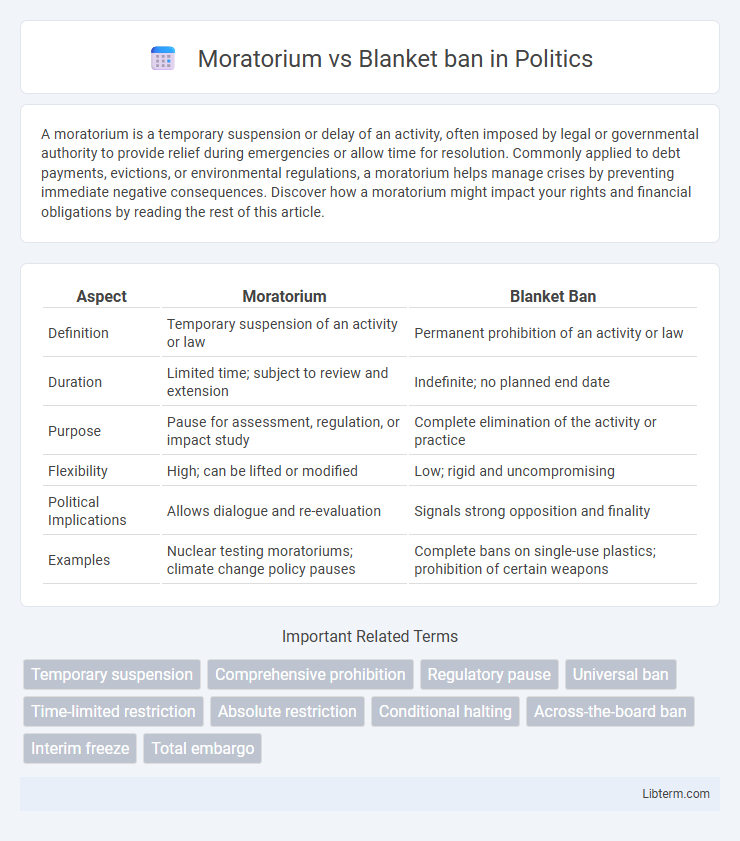A moratorium is a temporary suspension or delay of an activity, often imposed by legal or governmental authority to provide relief during emergencies or allow time for resolution. Commonly applied to debt payments, evictions, or environmental regulations, a moratorium helps manage crises by preventing immediate negative consequences. Discover how a moratorium might impact your rights and financial obligations by reading the rest of this article.
Table of Comparison
| Aspect | Moratorium | Blanket Ban |
|---|---|---|
| Definition | Temporary suspension of an activity or law | Permanent prohibition of an activity or law |
| Duration | Limited time; subject to review and extension | Indefinite; no planned end date |
| Purpose | Pause for assessment, regulation, or impact study | Complete elimination of the activity or practice |
| Flexibility | High; can be lifted or modified | Low; rigid and uncompromising |
| Political Implications | Allows dialogue and re-evaluation | Signals strong opposition and finality |
| Examples | Nuclear testing moratoriums; climate change policy pauses | Complete bans on single-use plastics; prohibition of certain weapons |
Introduction to Moratoriums and Blanket Bans
Moratoriums temporarily suspend specific activities or policies, allowing time for review, assessment, or adjustments, often used in environmental regulations or urban development projects. Blanket bans impose a complete and indefinite prohibition on certain actions or substances, typically applied to ensure strict compliance or to mitigate significant risks, such as weapons or hazardous chemicals. Understanding the distinction between moratoriums and blanket bans is critical for policy makers when balancing regulation flexibility with enforcement rigor.
Defining a Moratorium
A moratorium is a temporary suspension or delay of an activity or law, allowing for further review or evaluation before continuing or implementing enforcement. Unlike a blanket ban, which permanently prohibits an action or behavior across all contexts, a moratorium provides a pause without permanent prohibition. This distinction is crucial in policy-making, as moratoria offer flexibility for reconsideration and adjustment based on emerging data or societal impact.
Understanding a Blanket Ban
A blanket ban refers to a comprehensive prohibition that applies universally without exceptions, often implemented to address widespread concerns or risks. Unlike a moratorium, which temporarily halts activities pending further review or evidence, a blanket ban permanently restricts specific actions or products. This approach ensures no permissible loopholes, providing clear regulatory boundaries for enforcement agencies and stakeholders.
Key Differences Between Moratoriums and Blanket Bans
Moratoriums temporarily suspend specific activities or regulations to allow for review or evaluation, often with defined time limits and the possibility of renewal. Blanket bans impose an outright and indefinite prohibition across all relevant areas without exceptions or temporary considerations. The key differences lie in moratoriums' conditional, time-bound nature versus blanket bans' permanent and comprehensive restrictions.
Legal Implications of Both Approaches
A moratorium temporarily suspends certain activities by law, allowing for careful review and adjustment without permanently removing rights, which limits immediate legal liabilities but may create uncertainty for stakeholders. Blanket bans impose an outright, permanent prohibition on specific actions or products, often leading to more definitive legal clarity but increasing the risk of challenges based on overbreadth or infringement on constitutional rights. Both approaches require careful legislative drafting to balance public interest with potential claims of due process violations or regulatory overreach.
Advantages of Implementing a Moratorium
Implementing a moratorium allows for temporary suspension of specific activities, providing policymakers critical time to assess environmental, economic, and social impacts without permanent restrictions. This approach offers flexibility to modify regulations based on gathered data and stakeholder input, ensuring more informed decision-making. Moratoriums minimize immediate negative consequences while promoting sustainable practices and balancing development goals.
Drawbacks of Blanket Bans
Blanket bans often lead to unintended consequences by restricting a wide range of activities without addressing specific issues, which can stifle innovation and economic growth. These bans lack flexibility, making it difficult to adapt policies based on evolving circumstances or emerging data. Overly broad prohibitions can also create enforcement challenges and may disproportionately impact certain groups or industries, reducing overall fairness and effectiveness.
Case Studies: Real-World Examples
Case studies highlight the contrasting impacts of moratoriums and blanket bans on industries and communities. The California fracking moratorium allowed comprehensive environmental reviews, balancing energy needs and ecological protection, whereas India's blanket ban on e-waste imports aimed to curb hazardous contamination but faced enforcement challenges and economic disruptions. These examples demonstrate moratoriums' adaptive flexibility compared to the rigid, sometimes counterproductive nature of blanket prohibitions in regulatory practices.
Choosing the Right Approach: Factors to Consider
Choosing the right approach between a moratorium and a blanket ban requires evaluating the scope, duration, and flexibility needed for regulation. Moratoriums allow temporary suspension to assess impacts and gather data, making them suitable when uncertainty prevails or policy adjustment is anticipated. Blanket bans enforce permanent prohibition and are preferable when risks are well-understood and irreversible harm is a concern.
Conclusion: Balancing Regulation and Flexibility
A moratorium provides a temporary halt allowing time for evaluation and adjustment, while a blanket ban imposes an immediate and comprehensive prohibition. Effective regulatory strategies balance the need for flexibility with clear restrictions to adapt to evolving circumstances and emerging data. Striking this balance ensures protection without stifling innovation or causing unintended consequences.
Moratorium Infographic

 libterm.com
libterm.com